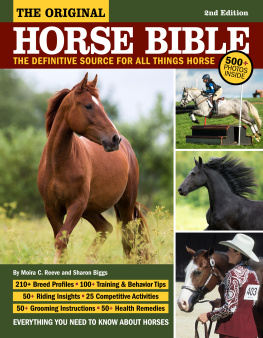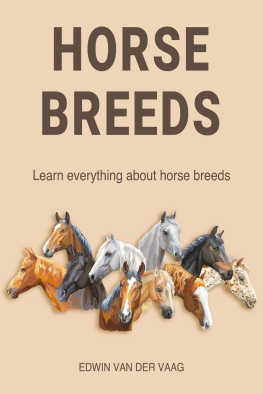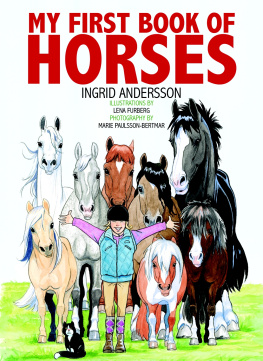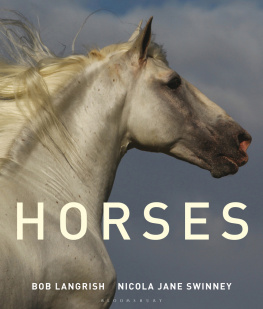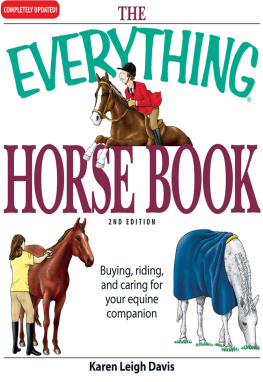Contents
Guide

The Original Horse Bible 2nd Edition
CompanionHouse Books is an imprint of Fox Chapel Publishing.
Project Team
Editor: Amy Deputato
Designer: Mary Ann Kahn
Proofreader: Hayley DeBerard
Copyright 2021 by Fox Chapel Publishing Company, Inc.
All rights reserved. No part of this book may be reproduced, stored in a retrieval system, or transmitted in any form or by any means, electronic, mechanical, photocopying, recording, or otherwise, without the prior written permission of Fox Chapel Publishing, except for the inclusion of brief quotations in an acknowledged review.
Print ISBN: 9781620084038
eISBN: 9781637410486
Library of Congress Control Number: 2021940899
Softcover
ISBN 978-1-62008-404-5
Library of Congress Control Number: 2021940891
This book has been published with the intent to provide accurate and authoritative information in regard to the subject matter within. While every precaution has been taken in the preparation of this book, the author and publisher expressly disclaim any responsibility for any errors, omissions, or adverse effects arising from the use or application of the information contained herein. The techniques and suggestions are used at the readers discretion and are not to be considered a substitute for veterinary care. If you suspect a medical problem, consult your veterinarian.

| Fox Chapel Publishing
903 Square Street
Mount Joy, PA 17552 |
www.facebook.com/companionhousebooks
We are always looking for talented authors. To submit an idea, please send a brief inquiry to acquisitions@foxchapelpublishing.com.
For Our Parents
Moira: Elizabeth and Arnold, who made my dreams of horses a reality
Sharon: Richard and Carol, who scraped the money together to send me to horse camp all those years ago
Contents

Preface
P eruse the shelves of your local bookstores and libraries and check out online book sites, and youll discover thousands of books on the subject of horses. From caring for a newborn foal to making the most of the lives of senior horses, from learning to ride in a weekend to competitive insights from Olympians, there is no shortage of information on the numerous facets of the equine world.
The Original Horse Bible is different from all of those other books, however, in that it is a comprehensive resource about all things horsey. This volume corrals all facets of horsekeeping to produce one handy resource for readers.
Whatever your skill level with horses may be, you will find something in this book for you: If you are new to horses, the book will serve as a practical guide for your first forays into the horse world. If you are a seasoned equestrian, the book will serve as a great reference tool and be an invaluable addition to your library or tack room.
Although no piece of writing can take the place of hands-on experience, knowledge about horses comes in many different forms, including books. Let The Original Horse Bible provide you with information about, and a better understanding of, horses so that your time spent with them is as enjoyable and as rewarding as possible.

Introduction
Look back on our struggle for freedom;
trace our present days strength to its source.
And youll find that mans pathway to glory
is strewn with the bones of a horse.
Anonymous
H orses and humansour history together is a long and storied one. No other animal has helped shape humanity quite as the horse has. Throughout the centuries, we have domesticated and developed horses for many purposes, including raising sustenance, transportation, recreation, and sport. They have been beasts of burden, partners in work and in war, loyal companions, and cherished family members. The roles horses play in our lives continue to evolve based on our needs, as well as on our desires. For this, we owe horses a debt of gratitude.
Over the millennia, these magnificent creatures have continued to captivate humankind, as evidenced in their portrayal in our art, our literature, and our music. Horses have always inspired; their very name is synonymous with power.
For all their strength and all their beauty, however, horses do have basic needs. They require a tremendous commitment of our time and financial resources to meet those needs. Proper attention to nutrition, health management, training, and overall well-being are but a few of the responsibilities of horse care; none of these responsibilities can be taken lightly. These duties are part of good horsemanship, which is a learning process that never ends. Each horse is special in his own way, with unique characteristics, personality, needs, likes, dislikes, fears, abilities, and talents.
It has been said that patience is a virtue. When it comes to horses, that adage is spot on. From the very basics of primary care to the intricacies of training and riding, we must take a slow, educated approach to instilling the necessary knowledge. For this reason, we hope that all equestrians out there will practice patience in their pursuits with horses. After all, theres no need to rushthe journey is far too enjoyable and rewarding not to be savored.
History, Physiology, and Behavior

Section 1
O ver time, the horse has been shaped by two very different forces: nature and man. Nature, of course, got there first and did the heavy worktaking a small, stubby, short-snouted forest creature, and crafting it into a tall, fast, plains-dwelling animal, with a regal profile. When people finally turned their attention to the horse, they began to tinker with the basic design, controlling reproduction to bring out the traits that would best serve individual purposes. Those purposes differed depending on location and kind of society. Thus the various types and breeds of horses came about. Understanding the horse should begin with learning how the modern horse evolved and why, as well as learning about the horses basic physiology and behavior.

The History of the Horse
T he idea that equine evolution occurred in a straight line has been debunked by contemporary science. Most researchers believe the horses evolutionary model is much more complex, with dozens of different equid types making their appearances on earth at given periods through the ages, some concurrently. Changes in environment led to evolutionary changes, creating new genera better adapted to those changes. Some of the new genera proved more successful than others. Ultimately, all but one of the genera died off, many of them within a few million years of their first appearance, leaving

